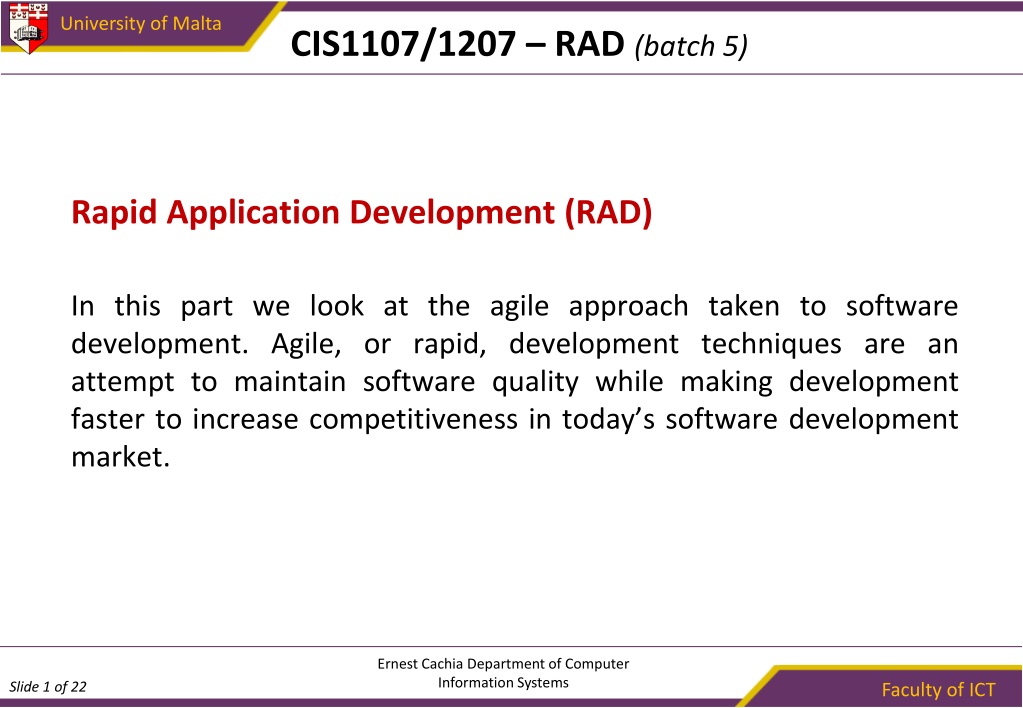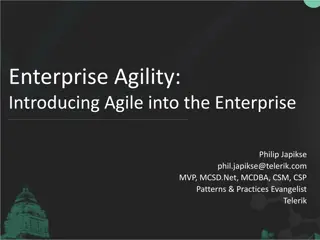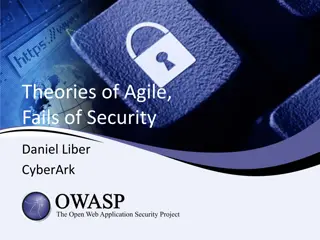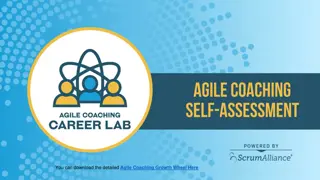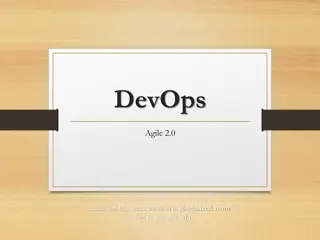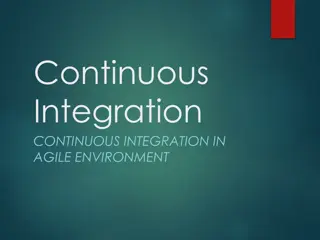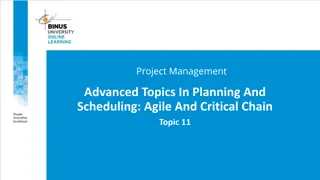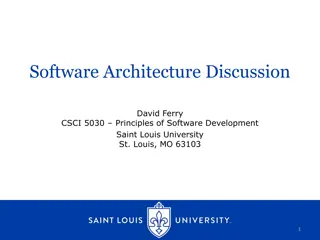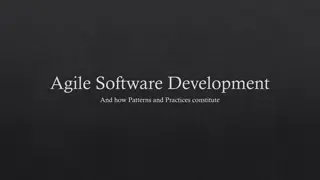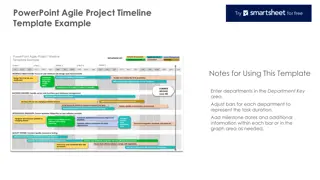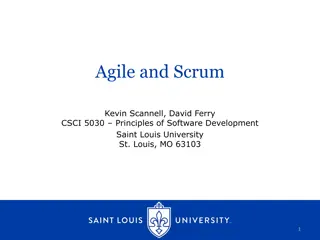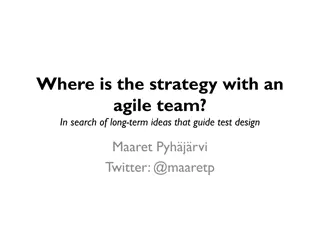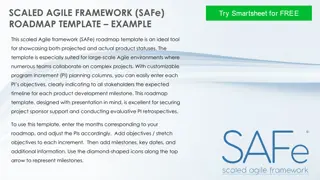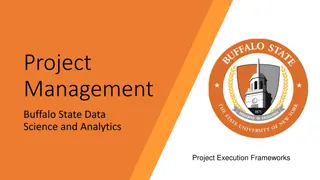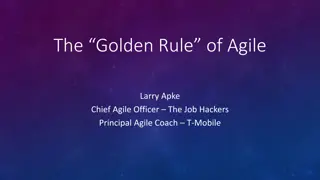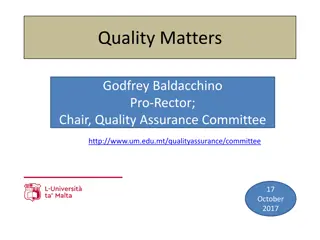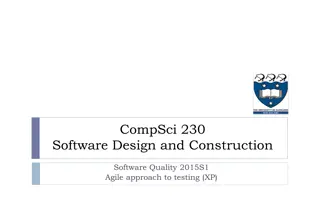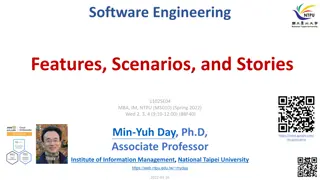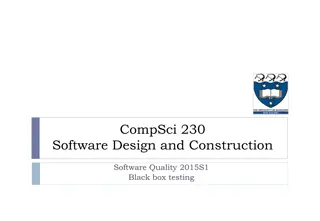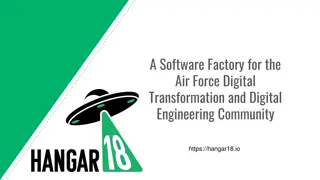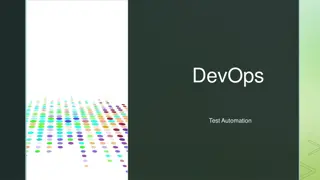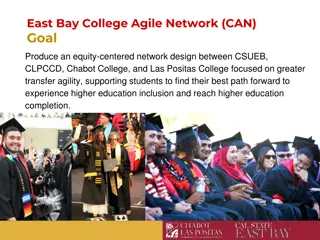Agile Software Development Principles at University of Malta
University of Malta follows Agile software development principles to prioritize individuals and interactions over processes and tools, focus on working solutions rather than comprehensive documentation, involve customers throughout the process, and remain adaptable to changes. The Rapid Application Development (RAD) approach includes active stakeholder participation, frequent and business-aligned deliverables, reversibility of development efforts, high-level requirements agreement, pervasive testing, and collaborative decision-making. Main RAD features at University of Malta include user involvement, strict delivery timelines, prototyping, effective use of modern development tools, reduced requirements analysis effort, and incremental development.
- Agile software development
- University of Malta
- RAD principles
- User involvement
- Rapid Application Development
Download Presentation

Please find below an Image/Link to download the presentation.
The content on the website is provided AS IS for your information and personal use only. It may not be sold, licensed, or shared on other websites without obtaining consent from the author. Download presentation by click this link. If you encounter any issues during the download, it is possible that the publisher has removed the file from their server.
E N D
Presentation Transcript
University of Malta CIS1107/1207 RAD (batch 5) Rapid Application Development (RAD) In this part we look at the agile approach taken to software development. Agile, or rapid, development techniques are an attempt to maintain software quality while making development faster to increase competitiveness in today s software development market. Ernest Cachia Department of Computer Information Systems Slide 1 of 22 Faculty of ICT
University of Malta Agile Development Principles 1. Priority given to individuals and interaction, rather than to processes and tools (trust, personal communication, quality of work, responsibility, self-management at micro-level) 2. Attention to working parts of solution, rather than to comprehensive documentation (tangible results, client reassurance, evident solution parts) 3. Importance to customer involvement, rather than contractual detachment (stakeholder participation, transparency, collaboration, feedback, client acceptance) 4. Reactive to change, rather than railed into a rigid plan (flexibility, relevance, result effectiveness, client satisfaction) General points only taken from www.agilealliance.org Ernest Cachia Department of Computer Information Systems Slide 2 of 22 Faculty of ICT
University of Malta RAD Principles 1. 2. 3. 4. All stakeholders - must take active part in decision taking - can take binding decisions Deliverables - are frequent - must clearly map on to the business process - are bite-sized All development effort is reversible Requirements are agreed upon at a high level - the method of their actual implementation is not that important Testing permeates the SDLC Collaboration, not competition between stakeholders is of essence 5. 6. Ernest Cachia Department of Computer Information Systems Slide 3 of 22 Faculty of ICT
University of Malta Main RAD Features User involvement Strict (and usually fast) delivery times Prototyping Effective use of modern development tools Reduction of the requirements capture and analysis effort Incremental development The next slides will go through each feature Ernest Cachia Department of Computer Information Systems Slide 4 of 22 Faculty of ICT
University of Malta User Involvement JAD Decision taking Sign-offs Prototype demos Bite size development focus Problem detection and correction Ernest Cachia Department of Computer Information Systems Slide 5 of 22 Faculty of ICT
University of Malta Strict Delivery Times Timebox approach 2 to 6 weeks Prioritisation (MoSCoW rules) Must, Should, Could, Want to have User agreement Power of decision Ernest Cachia Department of Computer Information Systems Slide 6 of 22 Faculty of ICT
University of Malta Prototyping The main communication tool in RAD Requires planning Serve as milestones Should be measureable Can take any form horizontal or vertical Is generally evolutionary in nature Ernest Cachia Department of Computer Information Systems Slide 7 of 22 Faculty of ICT
University of Malta Effective use of Modern Techniques The educated use of: Models Methods Techniques Technologies Environments Ernest Cachia Department of Computer Information Systems Slide 8 of 22 Faculty of ICT
Reduction of Requirements Capture and Analysis Effort University of Malta Less time on getting every part right as early as possible at model level, producing a ready solution. More time on doing smaller bits, asking for feedback, combining the bits to grow the solution. Shift of some analysis effort from developer to user. Ernest Cachia Department of Computer Information Systems Slide 9 of 22 Faculty of ICT
University of Malta Incremental Development The current version of evolves from a simpler previous version Development can be subdivided into manageable parts Requires good configuration management to work Small development chunks are a must Frequent deliverables are a must Ernest Cachia Department of Computer Information Systems Slide 10 of 22 Faculty of ICT
University of Malta DSDM- An SDLC based on RAD Dynamic Systems Development Method (DSDM) Is a standard used throughout the UK and a number of other countries. Yet others, use it sparingly Is an open method i.e. non-commercialised Is supported by a consortium also called the DSDM Consortium see site: dsdm.org (registration might be required) Ernest Cachia Department of Computer Information Systems Slide 11 of 22 Faculty of ICT
University of Malta The DSDM Framework From http://dsdm.org Ernest Cachia Department of Computer Information Systems Slide 12 of 22 Faculty of ICT
University of Malta DSDM Does not specify a particular method of development to use in its phases Just offers a framework upon which development may proceed and at which points and what sort of milestone to produce Really only covers analysis, design and implementation phases Ernest Cachia Department of Computer Information Systems Slide 13 of 22 Faculty of ICT
University of Malta RAD Principles (9 in all) (1/2) 1. Win-Win (my addition) 2. All stakeholders must take active part 3. All stakeholders can take binding decisions 4. Deliverables are frequent 5. Deliverables must clearly map on to the business process 6. Deliverables are bite-sized Ernest Cachia Department of Computer Information Systems Slide 14 of 22 Faculty of ICT
University of Malta RAD Principles (9 in all)(2/2) 7. All development effort is reversible 8. Requirements are agreed upon at a high level i.e. the method of their actual implementation is not that important 9. Testing permeates the SDLC 10. Collaboration, not competition between stakeholders is of essence Ernest Cachia Department of Computer Information Systems Slide 15 of 22 Faculty of ICT
University of Malta The DSDM Filter When to use DSDM? Answer these Is the functionality visible through the UIs? Can all end user classes be identified? Is the system heavy on computation? Is the system large and can it be sensibly split up? How time-constrained is the project? Are requirements abstract enough and can they change within limits? Ernest Cachia Department of Computer Information Systems Slide 16 of 22 Faculty of ICT
University of Malta Systems that can benefit from DSDM Interactive Based on UIs (functionally) User groups are clearly defined Not too complex Can be incrementally developed Time-wise guaranteed Requirements can be prioritised Requirements can undergo changes Ernest Cachia Department of Computer Information Systems Slide 17 of 22 Faculty of ICT
University of Malta Examples of Agile Methodologies XP (Taken to be generically representative of all the agile methodologies) This method was outlined in the previous slides Scrum (first created in 1994, commercially used in 2002/3) This method is based on iterative (usually 30-day) segments called sprints . Autonomous teams work in parallel on pre-prioritised requirements and synchronise through short daily meetings called Scrums . Crystal (2002) This method is developer-centric. It assumes that the main project quality driver is the quality of people. Also relies on frequent communication and less intermediate deliverables. Adaptive Software Development (2000) This is a feature-oriented method that is driven by the development of features as understood by the client. Change is expected and risk is tackled head-on by tackling the most complex issues first. Ernest Cachia Department of Computer Information Systems Slide 18 of 22 Faculty of ICT
University of Malta Summary The concepts behind agile development methods Rapid Application Development (RAD) Examples of some agile methodologies Ernest Cachia Department of Computer Information Systems Slide 19 of 22 Faculty of ICT
